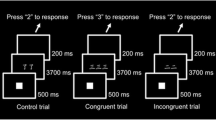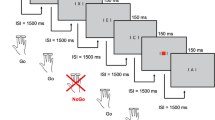Abstract
Attention Deficit/Hyperactivity Disorder (ADHD) is a behavioral disorder of childhood and adolescence characterized by symptoms that include impulsiveness, inattention, hyperactivity, impaired decision making, and primary deficits of executive functions. In a vast proportion of the diagnosed adolescents, the clinical symptoms may persist into adulthood and ADHD patients are characterized by Working Memory (WM) impairment. In the present study, we analyze brain dynamics by EEG recordings during the dual n-back task in a population of young adults with ADHD and healthy controls. The WM capacity and attention span are tested by n-back task, and divided attention is tested by running the task in the visual and auditory modalities concurrently. We analyzed the event-related potentials (ERPs) triggered by the onset of the audio-visual stimuli. In ADHD the amplitude of N200 wave component was only slightly reduced and the peak latency was unaffected. The amplitude of P300 peak was reduced in ADHD with respect to controls at all sites along the midline. The latency of P300 peak in ADHD was reduced at Fz and Cz. In particular, at Fz the latency of ADHD was reduced after a response that required matching the visual cue 1 or 2 trials back in time. These results support the hypothesis that the P300 component, associated with a cognitive workload, peaked earlier in the ADHD than in controls and it may be used to follow the outcome of cognitive training.
Access this chapter
Tax calculation will be finalised at checkout
Purchases are for personal use only
Similar content being viewed by others
References
American Psychiatric Association (APA). (2000). Diagnostic and statistical manual of mental disorders (4th, text rev. edition). American Psychiatric Association.
Ansari, S. (2015). The therapeutic potential of working memory training for treating mental disorders. Frontiers in Human Neuroscience, 9, 481.
Au, J., Sheehan, E., Tsai, N., Duncan, G. J., Buschkuehl, M., & Jaeggi, S. M. (2015). Improving fluid intelligence with training on working memory: A meta-analysis. Psychonomic Bulletin & Review, 22(2), 366–377.
Barker, R. M., & Bialystok, E. (2019). Processing differences between monolingual and bilingual young adults on an emotion n-back task. Brain and Cognition, 134, 29–43.
Barkley, R. A., & Fischer, M. (2010). The unique contribution of emotional impulsiveness to impairment in major life activities in hyperactive children as adults. Journal of the American Academy of Child and Adolescent Psychiatry, 49(5), 503–513.
Barry, R. J., Clarke, A. R., & Johnstone, S. J. (2003). A review of electrophysiology in Attention-Deficit/Hyperactivity Disorder: I. Qualitative and quantitative electroencephalography. Clinical Neurophysiology, 114(2), 171–183.
Bayerl, M., Dielentheis, T. F., Vucurevic, G., Gesierich, T., Vogel, F., Fehr, C., et al. (2010). Disturbed brain activation during a working memory task in drug-Naive adult patients with ADHD. Neuroreport, 21(6), 442–446.
Bédard, A.-C. V., Newcorn, J. H., Clerkin, S. M., Krone, B., Fan, J., Halperin, J. M., et al. (2014). Reduced prefrontal efficiency for visuospatial working memory in attention-deficit/hyperactivity disorder. Journal of the American Academy of Child and Adolescent Psychiatry, 53(9), 1020–1030.e6.
Blacker, K. J., Negoita, S., Ewen, J. B., & Courtney, S. M. (2017). N-back versus complex span working memory training. Journal of Cognitive Enhancement, 1(4), 434–454.
Brouwer, A.-M., Hogervorst, M. A., van Erp, J. B. F., Heffelaar, T., Zimmerman, P. H., & Oostenveld, R. (2012). Estimating workload using EEG spectral power and ERPs in the n-back task. Journal of Neural Engineering, 9(4), 045008.
Chuang, K.-Y., Chen, Y.-H., Balachandran, P., Liang, W.-K., & Juan, C.-H. (2019). Revealing the electrophysiological correlates of working memory-load effects in symmetry span task with HHT method. Frontiers in Psychology, 10, 855.
Conners, C. K., Erhardt, D., & Sparrow, E. (1999). Conner’s adult ADHD rating scales: Technical manual. Multi-Health Systems Incorporated (MHS).
Dong, S., Reder, L. M., Yao, Y., Liu, Y., & Chen, F. (2015). Individual differences in working memory capacity are reflected in different ERP and EEG patterns to task difficulty. Brain Research, 1616, 146–156.
Elosúa, M. R., Del Olmo, S., & Contreras, M. J. (2017). Differences in executive functioning in children with attention deficit and hyperactivity disorder (ADHD). Frontiers in Psychology, 8, 976.
Epstein, J. N., Langberg, J. M., Rosen, P. J., Graham, A., Narad, M. E., Antonini, T. N., et al. (2011). Evidence for higher reaction time variability for children with ADHD on a range of cognitive tasks including reward and event rate manipulations. Neuropsychology, 25(4), 427–441.
Faraone, S. V., Asherson, P., Banaschewski, T., Biederman, J., Buitelaar, J. K., Ramos-Quiroga, J. A., et al. (2015). Attention-deficit/hyperactivity disorder. Nature Reviews Disease Primers, 1, 15020.
Feige, B., Biscaldi, M., Saville, C. W. N., Kluckert, C., Bender, S., Ebner-Priemer, U., et al. (2013). On the temporal characteristics of performance variability in attention deficit hyperactivity disorder (ADHD). PLoS One, 8(10), e69674.
Folstein, J. R., & Van Petten, C. (2008). Influence of cognitive control and mismatch on the N2 component of the ERP: A review. Psychophysiology, 45(1), 152–170.
Forns, J., Esnaola, M., López-Vicente, M., Suades-González, E., Alvarez-Pedrerol, M., Julvez, J., et al. (2014). The n-back test and the attentional network task as measures of child neuropsychological development in epidemiological studies. Neuropsychology, 28(4), 519–529.
Fumeaux, P., Mercier, C., Roche, S., Iwaz, J., Bader, M., Stéphan, P., et al. (2016). Validation of the French version of Conners’ Parent Rating Scale Revised, short version: Factorial structure and reliability. Canadian Journal of Psychiatry, 61(4), 236–242.
Gevins, A., & Smith, M. E. (2000). Neurophysiological measures of working memory and individual differences in cognitive ability and cognitive style. Cerebral Cortex, 10(9), 829–839.
Jaeggi, S. M., Buschkuehl, M., Jonides, J., & Perrig, W. J. (2008). Improving fluid intelligence with training on working memory. Proceedings of the National Academy of Sciences of the United States of America, 105(19), 6829–6833.
Jung, T.-P., Humphries, C., Lee, T.-W., Makeig, S., McKeown, M. J., Iragui, V., & Sejnowsk, T. J. (1997). Extended ICA removes artifacts from electroencephalographic recordings. In Proceedings of the 10th International Conference on Neural Information Processing Systems, NIPS’97 (pp. 894–900). MIT Press.
Karatekin, C., Bingham, C., & White, T. (2009). Regulation of cognitive resources during an n-back task in youth-onset psychosis and attention-deficit/hyperactivity disorder (ADHD). International Journal of Psychophysiology, 73(3), 294–307.
Kasper, L. J., Alderson, R. M., & Hudec, K. L. (2012). Moderators of working memory deficits in children with attention-deficit/hyperactivity disorder (ADHD): A meta-analytic review. Clinical Psychology Review, 32(7), 605–617.
Käthner, I., Wriessnegger, S. C., Müller-Putz, G. R., Kübler, A., & Halder, S. (2014). Effects of mental workload and fatigue on the P300, alpha and theta band power during operation of an ERP (P300) brain-computer interface. Biological Psychology, 102, 118–129.
Keshavan, M. S., Vinogradov, S., Rumsey, J., Sherrill, J., & Wagner, A. (2014). Cognitive training in mental disorders: Update and future directions. American Journal of Psychiatry, 171(5), 510–522.
Kim, S., & Kim, M.-S. (2016). Deficits in verbal working memory among college students with attention-deficit/hyperactivity disorder traits: An event-related potential study. Clinical Psychopharmacology and Neuroscience, 14(1), 64–73.
Lilienthal, L., Tamez, E., Shelton, J. T., Myerson, J., & Hale, S. (2013). Dual n-back training increases the capacity of the focus of attention. Psychonomic Bulletin & Review, 20(1), 135–141.
Liu, Z.-X., Glizer, D., Tannock, R., & Woltering, S. (2016). EEG alpha power during maintenance of information in working memory in adults with ADHD and its plasticity due to working memory training: A randomized controlled trial. Clinical Neurophysiology, 127(2), 1307–1320.
Lövdén, M., Bäckman, L., Lindenberger, U., Schaefer, S., & Schmiedek, F. (2010). A theoretical framework for the study of adult cognitive plasticity. Psychological Bulletin, 136(4), 659–676.
Mahncke, H. W., Bronstone, A., & Merzenich, M. M. (2006). Brain plasticity and functional losses in the aged: Scientific bases for a novel intervention. Progress in Brain Research, 157, 81–109.
Massat, I., Slama, H., Kavec, M., Linotte, S., Mary, A., Baleriaux, D., et al. (2012). Working memory-related functional brain patterns in never medicated children with ADHD. PLoS One, 7(11), e49392.
McEvoy, L. K., Smith, M. E., & Gevins, A. (1998). Dynamic cortical networks of verbal and spatial working memory: Effects of memory load and task practice. Cerebral Cortex, 8(7), 563–574.
Mesrobian, S. K. (2015). Does working memory training affect decision making?: A neuroeconomic study. PhD thesis, Faculty of Medicine and Biology, University of Lausanne.
Mesrobian, S. K., Lintas, A., Jacquerod, M., Bader, M., Götte, L., & Villa, A. E. (2018a). An ERP study reveals how training with dual n-back task affects risky decision making in a gambling task in ADHD Patients. In J. M. Delgado-García, X. Pan, R. Sánchez-Campusano, & R. Wang (Eds.), Advances in cognitive neurodynamics (VI) (Chap. 34, pp. 271–277). Springer.
Mesrobian, S. K., Villa, A. E. P., Bader, M., Götte, L., & Lintas, A. (2018b). Event-related potentials during a gambling task in young adults with attention-deficit/hyperactivity disorder. Frontiers in Human Neuroscience, 12, 79.
Mies, G. W., Moors, P., Sonuga-Barke, E. J., van der Oord, S., Wiersema, J. R., Scheres, A., et al. (2018). A pilot study of behavioral, physiological, and subjective responses to varying mental effort requirements in attention-deficit/hyperactivity disorder. Frontiers in Psychology, 9, 2769.
Mun, S., Whang, M., Park, S., & Park, M.-C. (2017). Effects of mental workload on involuntary attention: A somatosensory ERP study. Neuropsychologia, 106, 7–20.
Oelhafen, S., Nikolaidis, A., Padovani, T., Blaser, D., Koenig, T., & Perrig, W. J. (2013). Increased parietal activity after training of interference control. Neuropsychologia, 51(13), 2781–27890.
R Core Team. (2013). R: A language and environment for statistical computing. R Foundation for Statistical Computing.
Roberts, W., Milich, R., & Fillmore, M. T. (2012). Constraints on information processing capacity in adults with ADHD. Neuropsychology, 26(6), 695–703.
Rogers, M., Hwang, H., Toplak, M., Weiss, M., & Tannock, R. (2011). Inattention, working memory, and academic achievement in adolescents referred for attention deficit/hyperactivity disorder (ADHD). Child Neuropsychology, 17(5), 444–458.
Roy, R. N., Charbonnier, S., Campagne, A., & Bonnet, S. (2016). Efficient mental workload estimation using task-independent EEG features. Journal of Neural Engineering, 13(2), 026019.
Salminen, T., Frensch, P., Strobach, T., & Schubert, T. (2016). Age-specific differences of dual n-back training. Neuropsychology, Development, and Cognition. Section B, Aging, Neuropsychology and Cognition, 23(1), 18–39.
Schecklmann, M., Ehlis, A.-C., Plichta, M. M., Dresler, T., Heine, M., Boreatti-Hümmer, A., et al. (2013). Working memory and response inhibition as one integral phenotype of adult ADHD? A behavioral and imaging correlational investigation. Journal of Attention Disorders, 17(6), 470–482.
Sonuga-Barke, E., Brandeis, D., Holtmann, M., & Cortese, S. (2014). Computer-based cognitive training for ADHD: A review of current evidence. Child and Adolescent Psychiatric Clinics of North America, 23(4), 807–824.
Stroux, D., Shushakova, A., Geburek-Höfer, A. J., Ohrmann, P., Rist, F., & Pedersen, A. (2016). Deficient interference control during working memory updating in adults with ADHD: An event-related potential study. Clinical Neurophysiology, 127(1), 452–463.
Venables, W. N., & Ripley, B. D. (2002). Modern applied statistics with S. Statistics and computing (4th ed., 498 pp.). Springer.
Vinogradov, S., Fisher, M., & de Villers-Sidani, E. (2012). Cognitive training for impaired neural systems in neuropsychiatric illness. Neuropsychopharmacology, 37(1), 43–76.
Watter, S., Geffen, G. M., & Geffen, L. B. (2001). The n-back as a dual-task: P300 morphology under divided attention. Psychophysiology, 38(6), 998–1003.
Wilcox, R., & Schönbrodt, F. (2016). A package of RR Wilcox’ robust statistics functions. R package version 0.30. https://github.com/nicebread/WRS/tree/master/pkg.
World Medical Association. (2013). World Medical Association Declaration of Helsinki: Ethical principles for medical research involving human subjects. JAMA, 310(20), 2191–2194.
Acknowledgements
This study was supported by the Swiss National Science Foundation (grant CR 1311-138032). We thank Damiano Cereghetti for his technical contribution to the computer implementation of the n-back task.
Author information
Authors and Affiliations
Editor information
Editors and Affiliations
Rights and permissions
Copyright information
© 2021 Springer Nature Singapore Pte Ltd.
About this paper
Cite this paper
Lintas, A., Mesrobian, S.K., Bader, M., Villa, A.E.P. (2021). ERPs in Controls and ADHD Patients During Dual N-Back Task. In: Lintas, A., Enrico, P., Pan, X., Wang, R., Villa, A. (eds) Advances in Cognitive Neurodynamics (VII). ICCN2019 2019. Advances in Cognitive Neurodynamics. Springer, Singapore. https://doi.org/10.1007/978-981-16-0317-4_20
Download citation
DOI: https://doi.org/10.1007/978-981-16-0317-4_20
Published:
Publisher Name: Springer, Singapore
Print ISBN: 978-981-16-0316-7
Online ISBN: 978-981-16-0317-4
eBook Packages: Biomedical and Life SciencesBiomedical and Life Sciences (R0)




